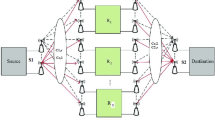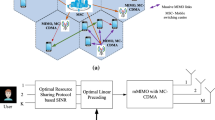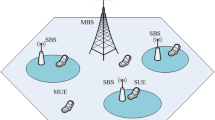Abstract
Multiple-input multiple-output (MIMO) systems invite many researchers to contribute more in channels selection for improving the performance for enhancing the throughput and quality of the received signal. It is important to notice that target channel selection will also improve the performance while decreasing the signal-interference-plus-noise ratio. In MIMO channel allocation, it is found that utilization of resources tends to be a dangerous issue which could be tackled by identifying secondary users in addition to primary user for disseminating the information. This paper focuses on allocating the dynamic channels effectively by applying a centralized heuristic algorithm which is referred as cuckoo search with improved elephant herding optimization. In the previous approach, poor resource allocation causes desperate issue in MIMO channel allocation while calculating the energy of each user available in the network. Substance near multicast protocol has been applied for optimizing the energy along with elephant herding optimization algorithm in order to allocate channels dynamically for global optimization process. An improved elephant herding optimization algorithm for multiuser MIMO framework is integrated in the overall remote region. This initiative signifies the greatest number of mutually legitimate clients and the feasible bit rates of clients in the overall remote region. The iEHO algorithm concurrently enhances energy proficiency and framework throughput by client assortment and power distribution. Our trial outcomes ascertained that the recommended method of working fundamentally excelled the essential EHO. Simulation has been done by using MATLAB which is assumed to be the best simulator to show the results without missing the clarity.















Similar content being viewed by others
References
Abualigah L (2019) Feature selection and enhanced krill herd algorithm for text document clustering. Studies in computational intelligence. Springer, Berlin, pp 1–165
Abualigah L (2020a) Multi-verse optimizer algorithm: a comprehensive survey of its results, variants, and applications. Neural Comput Appl 32:12381–12401
Abualigah L (2020b) Group search optimizer: a nature-inspired meta-heuristic optimization algorithm with its results, variants, and applications. Neural Comput Appl. https://doi.org/10.1007/s00521-020-05107-y
Abualigah L, Diabat A (2020) A novel hybrid antlion optimization algorithm for multi-objective task scheduling problems in cloud computing environments. Cluster Comput 23:1–19
Abualigah L, Khader AT (2017) Unsupervised text feature selection technique based on hybrid particle swarm optimization algorithm with genetic operators for the text clustering. J Supercomput 73(11):4773–4795
AI-Hussaibi WA, Ali FH (2019) Efficient user clustering, receive antenna selection, and power allocation algorithms for massive MIMO-NOMA systems. IEEE Access 7:31865–31882
Carbunar B, Pearce M, Mohapatra S, Rittle LJ, Vasudevan V, Carbunar O (2010) Secure synchronization of periodic updates in ad hoc networks. IEEE Trans Parallel Distrib Syst 21(8):1060–1073
Clarke P, de Lamare RC (2011) Joint transmit diversity optimization and relay selection for multi-relay cooperative MIMO systems using discrete stochastic algorithms. IEEE Commun Lett 15(10):1035–1037
Deroba JC, Schneider GJ, Schuetz CA, Prather DW (2018) Multifunction radio frequency photonic array with beam-space down-converting receiver. IEEE Trans Aerosp Electron Syst 54(6):2746–2761
El-Khamy SE, Eltrass AS, El-Sayed HF (2018) Design of thinned fractal antenna arrays for adaptive beam forming and sidelobe reduction. IET Microw Antennas Propag 12(3):435–441
Feng YH, Wang GG (2018a) Moth search algorithm: a bio-inspired metaheuristic algorithm for global optimization problems. Memet Comput 10(2):151–164
Feng YH, Wang GG (2018b) Binary moth search algorithm for discounted 0–1 knapsack problem. IEEE Access 6:10708–10719
Feng Y, Wang GG, Li W, Li N (2018) Multi-strategy monarch butterfly optimization algorithm for discounted 0–1 knapsack problem. Neural Comput Appl 30(10):3019–3036
Gao Y, Vinck H, Kaiser T (2017) Massive MIMO antenna selection: switching architectures, capacity bounds and optimal antenna selection algorithms. IEEE Trans Signal Process 66(5):1346–1360
Girsang AS, Yunanto A, Aslamiah AH (2017) A hybrid cuckoo search and K-means for clustering problem. In: International conference on electrical engineering and computer science (ICECOS), pp 47–51
Herbert S, Hopgood JR, Mulgrew B (2018) MMSE adaptive waveform design for active sensing with applications to MIMO radar. IEEE Trans Signal Process 66(5):147–153
Jia R, He D (2013) Complex valued cuckoo search with local search. In: 9th international conference on natural computation (ICNC), pp 14–21
Junling W, Pérez-Neira AI, Meiguov G (2013) A concise joint transmit/receive antenna selection algorithm. Digit Commun 10(3):91–99
Kokshoorn M, Chen H, Wang P, Li Y, Vucetic B (2017) Millimeter wave MIMO channel estimation using overlapped beam patterns and rate adaptation. IEEE Trans Signal Process 65(3):164–173
Li J, Lei H, Alavi AH, Wang G-G (2020) Elephant herding optimization: variants, hybrids, and applications. Mathematics 8(9):1415
Mai VV, Kim H (2019) Beam size optimization and adaptation for high-altitude airborne free-space optical communication systems. IEEE Photonics J 11(2):1–13
Mandal S (2018) Elephant swarm water search algorithm for global optimization. Sadhana 43(1):1–21
Palaiah A, Prabhu AH, Agrawal R, Natarajan S (2016) Clustering using cuckoo search levy flight. In: International conference on advances in computing, communications and informatics (ICACCI), pp 84–91
Puri P, Garg P, Aggarwal M (2016) Multiple user pair scheduling in TWR assisted FSO systems. J Opt Commun Netw 8(5):290–301
Sigdel S, Krzymien WA (2009) Simplified fair scheduling and antenna selection algorithms for multiuser MIMO orthogonal space-division multiplexing downlink. IEEE Trans Veh Technol 58(3):1329–1344
Song D, Chen CW (2007) Scalable H.264/AVC video transmission over MIMO wireless systems with adaptive channel selection based on partial channel information. IEEE Trans Circuits Syst Video Technol 17(9):1218–1226
Tang H, Nie Z (2017) RMV antenna selection algorithm for massive MIMO. IEEE Signal Process 99:1–1
Tang T-W, Tien H-T, Lu H-F (2015) Selection and rate-adaptation schemes for MIMO multiple-access channels with low-rate channel feedback. IEEE Trans Inf Theory 61(11):5948–5975
Truong KT, Heath RW (2010) Multimode antenna selection for MIMO amplify-and-forward relay systems. IEEE Trans Signal Process 58(11):5845–5859
Tuba E, Stanimirovic Z (2017) Elephant herding optimization algorithm for support vector machine parameters tuning. In: 9th international conference on electronics, computers and artificial intelligence (ECAI), pp 1–4
Wang G-G, Deb S, Coelho LS (2015) Elephant herding optimization. In: IEEE 3rd international symposium on computational and business intelligence, Bali, Indonesia, pp 1–5
Wang G-G, Deb S, Xiao-ZhiGao L, Coelho LS (2016) A new metaheuristic optimization algorithm motivated by elephant herding behavior. Int J Bio-Inspir Comput 8(6):394–409
Wang G-G, Deb S, Coelho LDS (2018) Earthworm optimization algorithm: a bio-inspired metaheuristic algorithm for global optimization problems. Int J Bio-Inspir Comput 12(1):1–22
Wang G-G, Deb S, Cui Z (2019) Monarch butterfly optimization. Neural Comput Appl 31(7):1995–2014
Woźniak M, Połap D (2014) Basic concept of cuckoo search algorithm for 2D images processing with some research results an idea to apply cuckoo search algorithm in 2D images key-points search. In: Proceedings of the 11th international conference on signal processing and multimedia applications (SIGMAP-2014), pp 157–164
Xu YF, Yu X, Wang G-G (2019) A novel monarch butterfly optimization with global position updating operator for large-scale 0–1 knapsack problems. Mathematics 7(11):1056
Zefan C, Xiaodong Y (2017) Cuckoo search algorithm with deep search, In: 3rd international conference, pp 78–85
Zhang M, Zhu Z, Cui Z (2017) Weighted-based oriented cuckoo search. In: The 9 international conference on modelling, identification and control (ICMIC 2017), Kunming, China, pp 85–91
Zhang G, Liu F, Liu J, JianwenLuo Y, Bai J, Xing L (2017b) Cone beam X-ray luminescence computed tomography based on Bayesian method. IEEE Trans Med Imaging 36(1):225–231
Zurakhov G, Tong L, Ramalli A, Tortoli P, D’hooge J, Friedman Z, Adam D (2018) Multiline transmit beam forming combined with adaptive apodization. IEEE Trans Ultrason Ferroelectr Freq Control 65(4):67–78
Author information
Authors and Affiliations
Corresponding author
Ethics declarations
Conflict of interest
The authors declare that they have no conflict of interest.
Additional information
Communicated by V. Loia.
Publisher's Note
Springer Nature remains neutral with regard to jurisdictional claims in published maps and institutional affiliations.
Rights and permissions
About this article
Cite this article
Velusamy, Y., Manickam, R., Chinnaswamy, S. et al. Adaptive beam formation and channel allocation using substance near multicast protocol and CS-iEHO. Soft Comput 25, 4663–4676 (2021). https://doi.org/10.1007/s00500-020-05476-5
Published:
Issue Date:
DOI: https://doi.org/10.1007/s00500-020-05476-5




